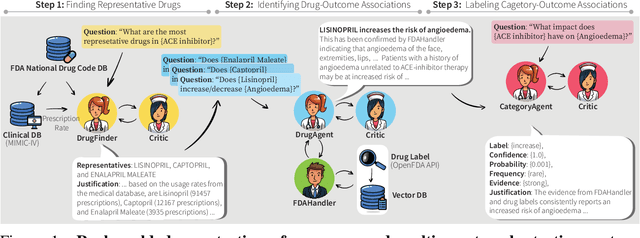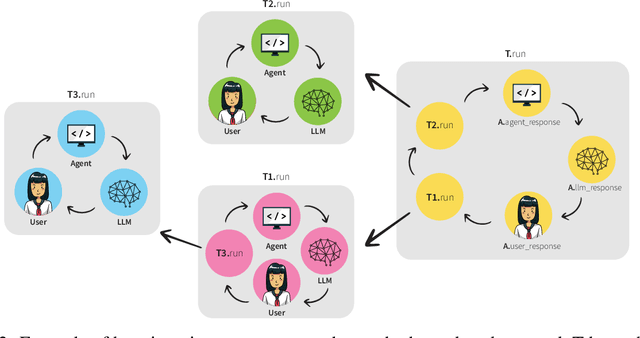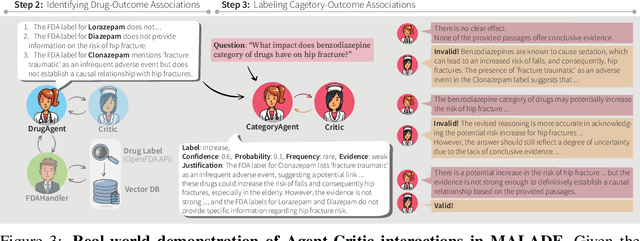Matthew M. Engelhard
MALADE: Orchestration of LLM-powered Agents with Retrieval Augmented Generation for Pharmacovigilance
Aug 03, 2024



Abstract:In the era of Large Language Models (LLMs), given their remarkable text understanding and generation abilities, there is an unprecedented opportunity to develop new, LLM-based methods for trustworthy medical knowledge synthesis, extraction and summarization. This paper focuses on the problem of Pharmacovigilance (PhV), where the significance and challenges lie in identifying Adverse Drug Events (ADEs) from diverse text sources, such as medical literature, clinical notes, and drug labels. Unfortunately, this task is hindered by factors including variations in the terminologies of drugs and outcomes, and ADE descriptions often being buried in large amounts of narrative text. We present MALADE, the first effective collaborative multi-agent system powered by LLM with Retrieval Augmented Generation for ADE extraction from drug label data. This technique involves augmenting a query to an LLM with relevant information extracted from text resources, and instructing the LLM to compose a response consistent with the augmented data. MALADE is a general LLM-agnostic architecture, and its unique capabilities are: (1) leveraging a variety of external sources, such as medical literature, drug labels, and FDA tools (e.g., OpenFDA drug information API), (2) extracting drug-outcome association in a structured format along with the strength of the association, and (3) providing explanations for established associations. Instantiated with GPT-4 Turbo or GPT-4o, and FDA drug label data, MALADE demonstrates its efficacy with an Area Under ROC Curve of 0.90 against the OMOP Ground Truth table of ADEs. Our implementation leverages the Langroid multi-agent LLM framework and can be found at https://github.com/jihyechoi77/malade.
Improving Event Time Prediction by Learning to Partition the Event Time Space
Oct 24, 2023



Abstract:Recently developed survival analysis methods improve upon existing approaches by predicting the probability of event occurrence in each of a number pre-specified (discrete) time intervals. By avoiding placing strong parametric assumptions on the event density, this approach tends to improve prediction performance, particularly when data are plentiful. However, in clinical settings with limited available data, it is often preferable to judiciously partition the event time space into a limited number of intervals well suited to the prediction task at hand. In this work, we develop a method to learn from data a set of cut points defining such a partition. We show that in two simulated datasets, we are able to recover intervals that match the underlying generative model. We then demonstrate improved prediction performance on three real-world observational datasets, including a large, newly harmonized stroke risk prediction dataset. Finally, we argue that our approach facilitates clinical decision-making by suggesting time intervals that are most appropriate for each task, in the sense that they facilitate more accurate risk prediction.
On Neural Networks as Infinite Tree-Structured Probabilistic Graphical Models
May 27, 2023Abstract:Deep neural networks (DNNs) lack the precise semantics and definitive probabilistic interpretation of probabilistic graphical models (PGMs). In this paper, we propose an innovative solution by constructing infinite tree-structured PGMs that correspond exactly to neural networks. Our research reveals that DNNs, during forward propagation, indeed perform approximations of PGM inference that are precise in this alternative PGM structure. Not only does our research complement existing studies that describe neural networks as kernel machines or infinite-sized Gaussian processes, it also elucidates a more direct approximation that DNNs make to exact inference in PGMs. Potential benefits include improved pedagogy and interpretation of DNNs, and algorithms that can merge the strengths of PGMs and DNNs.
 Add to Chrome
Add to Chrome Add to Firefox
Add to Firefox Add to Edge
Add to Edge